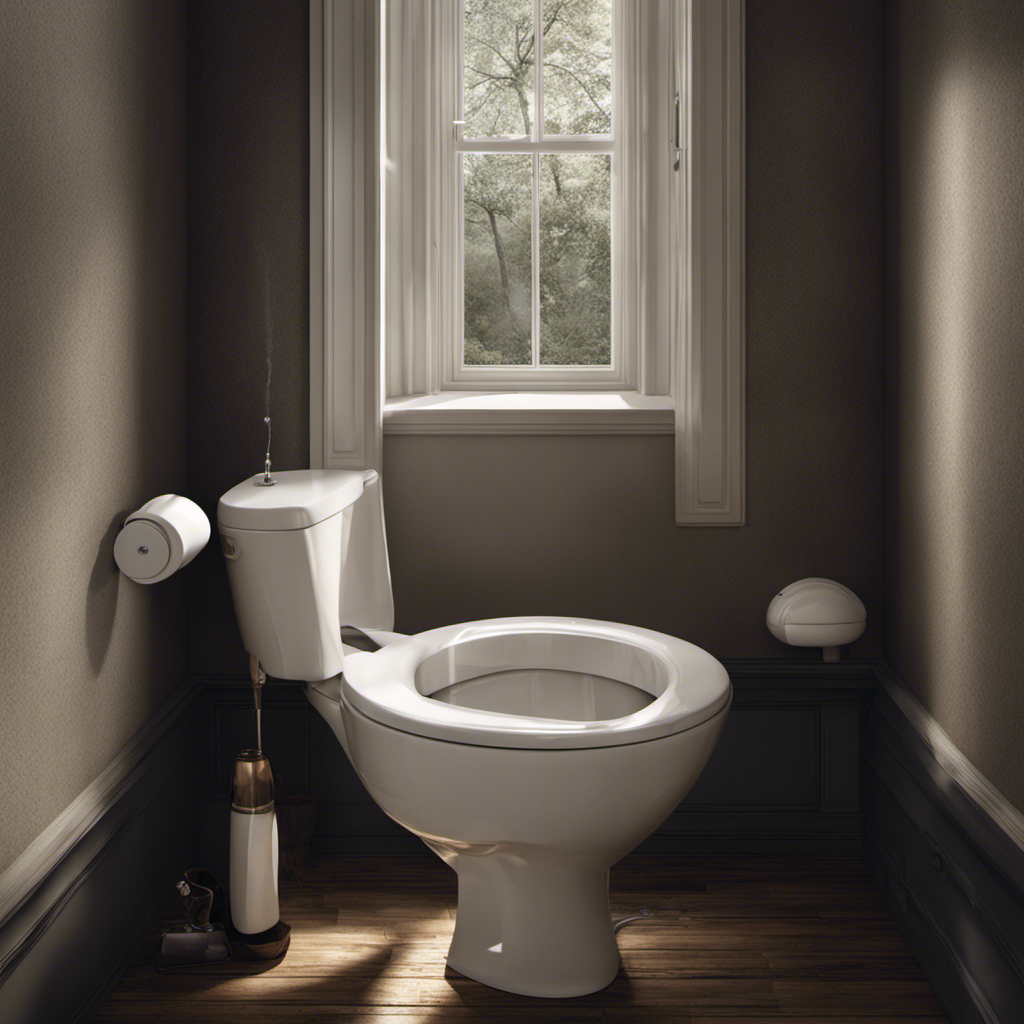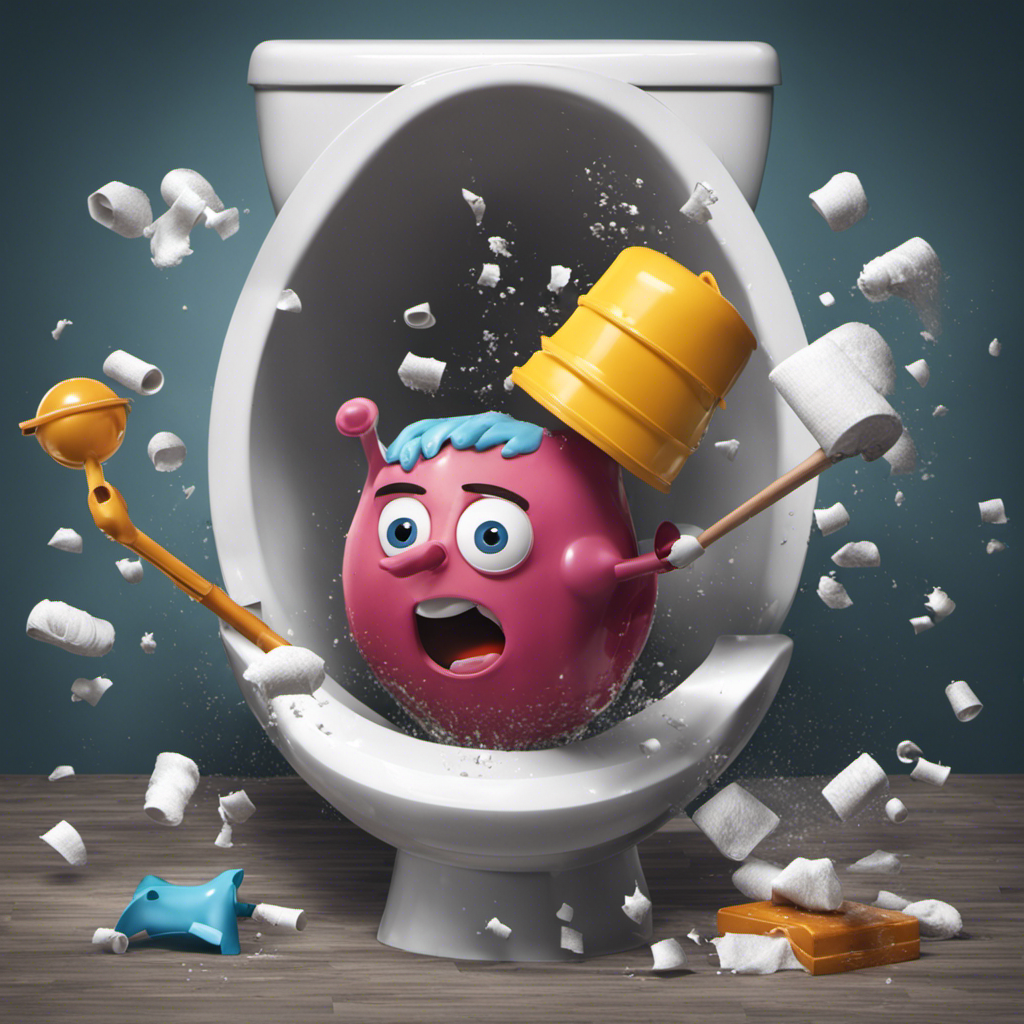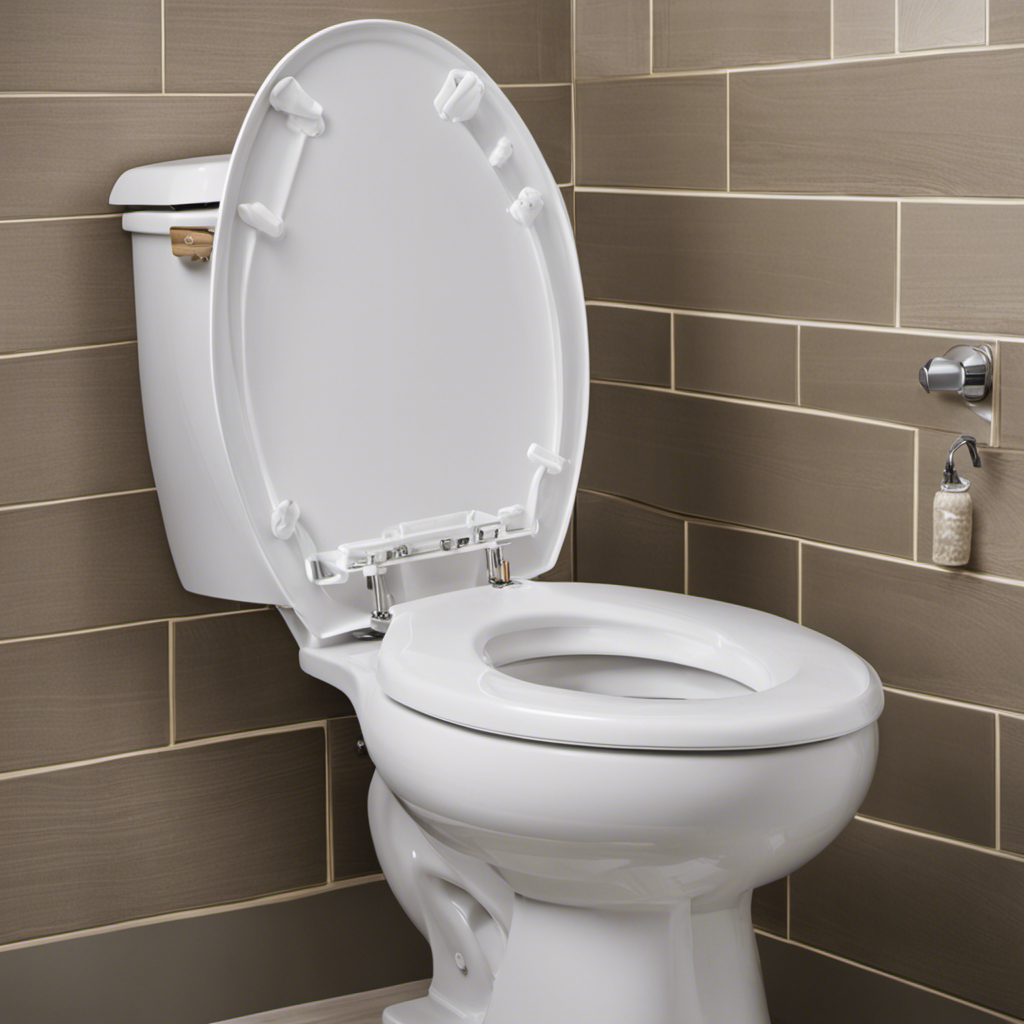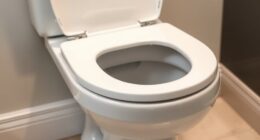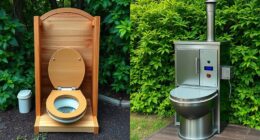Have you ever wondered why your toilet squeals when you flush it? Well, I’ve got some answers for you.
In this article, we’ll be diving into the common causes of toilet squealing, including issues with water pressure, faulty fill valves, water hammer, blockages, and faulty flapper valves.
We’ll also explore DIY fixes and when it’s best to seek professional help.
So, if you’re tired of the high-pitched symphony every time you use the bathroom, keep reading for some valuable insights.
Key Takeaways
- Faulty fill valves and worn or damaged flapper valves are common causes of toilet squealing.
- High water pressure can lead to vibrations and noise, while low water pressure can result in incomplete flushing.
- Water hammer, caused by interrupted water flow, can create loud banging noises in toilets.
- Blockages in the toilet can cause pressure buildup and unusual noises, so regular maintenance is important to prevent them.
Common Causes of Toilet Squealing
One common cause of your toilet squealing when you flush it is a faulty fill valve. The fill valve is responsible for regulating the flow of water into the toilet tank. If it becomes worn or damaged, it can lead to a high-pitched squealing noise.
To troubleshoot the issue, you can start by checking the water pressure in your home. High water pressure can put extra strain on the fill valve, causing it to malfunction. If the water pressure is too high, you may need to install a pressure regulator to alleviate the problem.
Another possible solution is to replace the flapper valve, which controls the flow of water from the tank to the bowl. By addressing these common issues, you can resolve the squealing noise and ensure proper toilet functionality.
Understanding the role of water pressure is crucial in maintaining a well-functioning toilet system.
Understanding the Role of Water Pressure
Understanding the role of water pressure helps to explain why toilets sometimes make a high-pitched noise when being flushed.
Water pressure is the force that pushes water through the pipes and into our homes. When it comes to toilets, water pressure plays a crucial role in the flushing process.
If the water pressure is too high, it can cause the water to rush through the pipes too quickly. This sudden rush of water can create vibrations and turbulence, resulting in the high-pitched noise.
On the other hand, if the water pressure is too low, it may not provide enough force to fully flush the toilet, leading to incomplete flushing and potential clogs.
Troubleshooting and identifying water pressure issues can help resolve these problems and ensure proper functioning of the toilet.
The Impact of Faulty Fill Valves on Toilet Sounds
The impact of faulty fill valves on toilet sounds can be significant. They can cause irregular water flow and disruptive noises. Fill valve problems can lead to various issues, including low water pressure or excessive water flow. Both of these can affect the sound produced when flushing a toilet.
When the fill valve is not functioning properly, it may not allow enough water to enter the tank. This can result in weak or incomplete flushing, causing the toilet to make a high-pitched squealing sound. On the other hand, if the fill valve is stuck open, it can lead to a constant flow of water, creating a loud and continuous noise.
These fill valve problems can often be resolved by replacing the faulty valve and ensuring proper water pressure is maintained.
As we explore the issue of water hammer in toilets, it’s important to understand how it can also contribute to disruptive sounds during flushing.
Exploring the Issue of Water Hammer in Toilets
When you experience water hammer in your toilet, it can result in loud banging noises that can be quite disruptive.
Water hammer occurs when the flow of water in your plumbing system is suddenly interrupted, causing a shockwave that travels through the pipes. This shockwave can cause vibrations and pressure fluctuations, leading to the banging noises you hear.
Water hammer can have negative effects on your plumbing system, such as damaged pipes, loose fittings, and even leaks.
To prevent water hammer, you can install water hammer arrestors, which are devices that absorb the shockwaves and prevent them from causing damage.
It’s important to address water hammer issues promptly to avoid further damage to your plumbing system and maintain its proper functioning.
How Blockages Affect Toilet Squealing
Blockages in your plumbing system can cause a squealing noise in toilets. It’s important to understand how blockages can affect your toilet and what signs to look out for.
One of the most common signs of a blocked toilet is when water drains slowly or doesn’t drain at all. This can lead to a buildup of pressure, causing the toilet to make unusual noises when flushed.
To prevent blockages, it’s essential to avoid flushing items like paper towels, sanitary products, or excessive amounts of toilet paper. Additionally, regular maintenance, such as using drain cleaners or having your pipes inspected, can help prevent blockages from occurring.
Now, let’s explore the role of faulty flapper valves in toilet noises.
The Role of Faulty Flapper Valves in Toilet Noises
If you’re experiencing a high-pitched noise after you’ve flushed, it could be due to a faulty flapper valve. The flapper valve is a crucial component of your toilet’s flushing mechanism. When it becomes worn or damaged, it can disrupt the water flow and cause the annoying squealing sound. Proper maintenance of the flapper valve is essential to prevent such issues. Regularly inspecting and cleaning the valve can help ensure its smooth functioning. Additionally, checking the water flow in your toilet can also have an impact on the noise level. A restricted water flow can put extra pressure on the flapper valve, leading to increased noise. By maintaining the flapper valve and ensuring a steady water flow, you can eliminate the squealing sound and enjoy a peaceful flushing experience.
| Flapper Valve Maintenance | Impact of Water Flow |
|---|---|
| Regular inspection | Checking water flow |
| Cleaning | Restricting flow |
| Replacement if damaged |
Troubleshooting Toilet Squealing: DIY Fixes and Professional Help
When it comes to troubleshooting a squealing toilet, there are DIY fix options that can be explored before seeking professional help. These DIY fixes include adjusting the water level, cleaning the flapper valve, or replacing the flapper valve altogether.
However, it is important to know when it is time to seek professional help. This may be necessary if the issue persists despite attempting DIY fixes or if the problem is beyond your expertise.
DIY Fix Options
To fix the squealing noise when you flush your toilet, you can try adjusting the water level in the tank. Here are three DIY fix options to consider:
-
Check the water level: Ensure that the water level in the tank is set correctly. If it’s too high, it could be causing the squealing noise. Adjust the float or the fill valve to achieve the recommended water level.
-
Inspect the fill valve: A faulty fill valve can also lead to toilet squealing. Check for any mineral deposits or debris that may be affecting its performance. Clean or replace the fill valve as needed.
-
Replace the ballcock assembly: If the squealing persists, the ballcock assembly might be the culprit. Over time, these parts can wear out or become damaged, leading to noise issues. Consider replacing the ballcock assembly to resolve the problem.
When to Seek Professional Help
You may want to consider seeking professional help if the DIY fix options do not resolve the squealing noise in your toilet. While there are certain signs of a serious toilet issue that may require a plumber’s expertise, it’s important to know when to call a professional for toilet problems.
One sign of a serious issue is if the squealing noise persists even after attempting DIY fixes such as adjusting the water level or replacing the flapper valve.
Another sign is if you notice any leaks or water damage around the base of the toilet.
Additionally, if you experience frequent clogs or backups, it may indicate a more significant problem.
In these cases, it’s best to contact a plumber who can accurately diagnose and fix the issue to prevent further damage to your toilet and plumbing system.
Frequently Asked Questions
How Do I Fix a Squealing Toilet Without Calling a Professional?
To fix a squealing toilet without calling a professional, check the toilet tank for any loose parts. Adjust the water pressure by turning the valve slightly, ensuring it’s not too high. These simple steps can often resolve the issue.
Can a Faulty Fill Valve Cause Other Issues With My Toilet?
A faulty fill valve can lead to numerous issues with your toilet. Troubleshooting the toilet fill valve is necessary to prevent leaks, water wastage, and inconsistent flushing. Look out for signs of a faulty fill valve, such as constant running or inadequate water levels.
Can Water Hammer in Toilets Cause Damage to the Plumbing System?
Water hammer prevention techniques are important to avoid damage to the plumbing system. It can cause pressure spikes that may affect other fixtures. Properly securing pipes and installing water hammer arrestors can help prevent this issue.
Are There Any Specific Types of Blockages That Can Cause Toilet Squealing?
There are several specific blockage types that can cause common toilet noises like squealing. These blockages can include foreign objects, mineral buildup, or even a clogged vent pipe.
How Do Faulty Flapper Valves Contribute to Toilet Noises?
Replacing faulty flapper valves can help troubleshoot toilet noises. When the flapper valve doesn’t seal properly, it can cause squealing sounds during flushing. So, a toilet flapper replacement is necessary to fix this issue.
Conclusion
Well, who knew that a simple act of flushing the toilet could turn into a symphony of squeals?
It’s like a magical orchestra of plumbing problems, each taking their turn to serenade you with their high-pitched melodies.
But fear not, for understanding the common causes of toilet squealing can help you silence this unwanted concert.
From water pressure issues to faulty valves and blockages, there are various culprits to blame.
So grab your plumber’s hat and get ready to troubleshoot, because it’s time to bring harmony back to your bathroom.
